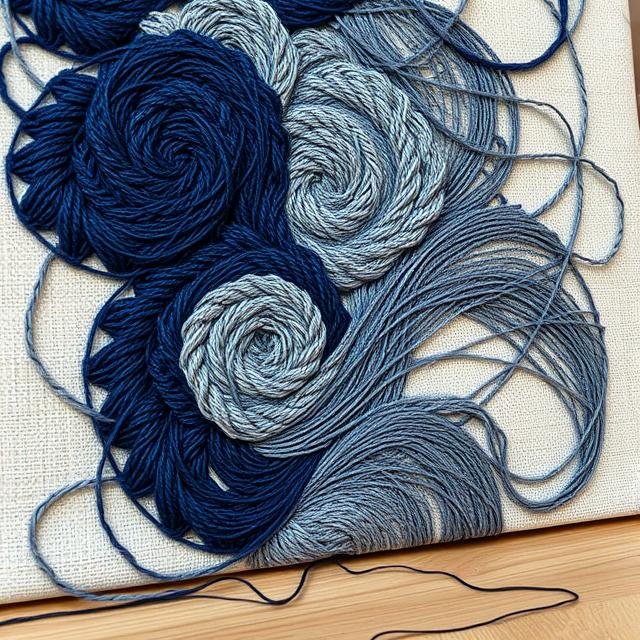In the vast and vibrant tapestry of contemporary art, where digital media and large-scale installations often dominate the conversation, there exists a quieter, yet profoundly resonant, thread: textile art. This ancient practice, once relegated to the realms of craft and domesticity, has been powerfully reclaimed by artists who see fiber not as a limitation, but as a language. Among the most compelling and innovative voices in this movement is the German artist, Carmela Clouth. Her work is a masterful synthesis of material, process, and concept, inviting viewers into a tactile world where thread becomes line, fabric becomes canvas, and stitch becomes a deliberate, meditative mark.
Clouth’s artistic journey is not one of loud declarations but of quiet, persistent exploration. She operates at the fascinating intersection of drawing, painting, and textile manipulation. Her primary medium is thread, which she uses to “draw” directly onto a foundational fabric, often linen or cotton. This process, reminiscent of traditional embroidery, is transformed in her hands into something entirely contemporary and abstract. The needle is her pencil, the thread her graphite or paint, and the stretched fabric her paper.
Table of Contents
The Alchemy of Process and Material
What sets Carmela Clouth apart is her profound respect for her materials and the alchemy of her process. She does not simply use thread to fill in a pre-drawn pattern. Instead, she engages in a dynamic, responsive dialogue with the fabric. Her compositions emerge organically. She might begin with a loose idea—a memory of a landscape, a emotional state, or a purely formal concern with line and density—but the work evolves stitch by stitch.
She employs a variety of techniques, primarily building up dense, intricate fields of color and texture using a free-motion sewing machine. This tool allows her unprecedented freedom, enabling her to move the fabric in any direction, creating swirling vortices, delicate hatching, and dense, impasto-like areas that bulge from the surface. The back of her works is often as visually interesting as the front, a testament to the continuous, flowing nature of her line. She frequently incorporates hand-stitching, adding a slower, more intimate rhythm to the machine’s frenetic energy. Sometimes, she paints or dyes the base fabric, allowing glimpses of color to peek through the complex web of threads, adding depth and a sense of history.
Thematic Undercurrents: Memory, Landscape, and the Unseen
While formally abstract, Clouth’s work is deeply evocative. It rarely depicts recognizable scenes but instead translates experiences into a visual language of texture and rhythm. Two recurring themes are particularly potent:
- Landscape and Topography: Many of her pieces feel like aerial maps of imagined territories or microscopic views of organic cellular structures. The layered threads create ridges, valleys, and plains, mapping not the physical reality of a place, but its emotional and mnemonic essence. A work might capture the chaotic energy of a crowded cityscape or the serene, repetitive pattern of a plowed field at dawn, all through the accumulation of stitch.
- Memory and Time: The very act of stitching is an investment of time. Each minute is physically embedded into the work. Clouth’s art embodies this concept. The dense, labor-intensive surfaces are archives of hours, days, and weeks of focused labor. They speak to the slow accumulation of memory, the way experiences layer upon one another, sometimes obscuring, sometimes highlighting what lies beneath. Her works are palimpsests of thread, where the history of their own making is visibly present.
A Quiet Revolution in a Digital Age
In an era defined by speed, digital replication, and the ephemeral, Carmela Clouth’s art is a powerful counterpoint. It is resolutely physical, slow, and handmade. The viewer is compelled to come closer, to see the individual stitches, to appreciate the immense labor and decision-making in every inch. This intimacy creates a unique connection between the artwork and the observer, one based on a shared understanding of time and touch.
Her work champions the idea that “craft” media are not separate from “fine art” but are instead a rich and complex vocabulary capable of expressing the most sophisticated contemporary ideas. She, along with a cohort of international fiber artists, has been instrumental in dismantling these outdated hierarchies, proving that the needle can be as expressive as the brush.
Carmela Clouth may not be a household name in the mainstream art world, and that is perhaps fitting. Her work doesn’t seek headlines; it seeks contemplation. It asks us to slow down, to appreciate the beauty in a single line of thread, and to consider the profound stories that can be woven from the most humble of materials. In doing so, she doesn’t just create art; she reconnects us to the fundamental human impulse to make, to mend, and to leave a mark—one stitch at a time.
Informational FAQs About Carmela Clouth
Q1: Who is Carmela Clouth?
A: Carmela Clouth is a contemporary German artist known for her innovative abstract textile works. She uses thread and a sewing machine as her primary mediums to create dense, textured compositions that blur the lines between drawing, painting, and fiber art.
Q2: What techniques does Carmela Clouth use?
A: Her primary technique is free-motion machine embroidery, which allows her to “draw” with thread by moving the fabric freely under the needle. She often combines this with hand-stitching and sometimes incorporates painting or dyeing on the base fabric to add depth and color.
Q3: What are the main themes in her artwork?
A: While abstract, her work frequently evokes themes of memory, time, and landscape. She translates these concepts into tactile, visual experiences through the layered accumulation of stitches, creating pieces that feel like maps of emotional or remembered spaces.
Q4: Where can I see Carmela Clouth’s work in person?
A: Her work is exhibited in galleries and museums primarily in Europe, particularly in Germany. The best way to find current and upcoming exhibitions is to check the websites of contemporary art galleries that specialize in textile art or represent her work. Art fairs focusing on modern craft and fiber art are also potential venues.
Q5: How is her work significant in the context of modern art?
A: Clouth is part of a significant movement that has elevated textile arts from a “craft” to a respected fine art medium. Her work challenges historical boundaries and demonstrates the conceptual and expressive power of fiber, contributing to a broader and more inclusive definition of contemporary artistic practice.
Q6: Has she published any books or catalogs about her work?
A: Information on specific monographs can be scarce. However, she has likely been featured in group exhibition catalogs and books surveying the field of contemporary textile art. Researching academic and art library databases for publications on “art textiles,” “contemporary embroidery,” or “materiality in art” may yield resources that include her work.
Q7: Is her work available for purchase, and how is it priced?
A: As an established artist, her original works are available for acquisition, typically through the galleries that represent her. Pricing for original textile art of her caliber is influenced by size, complexity, materials, and her exhibition history. It is considered investment-level fine art.

